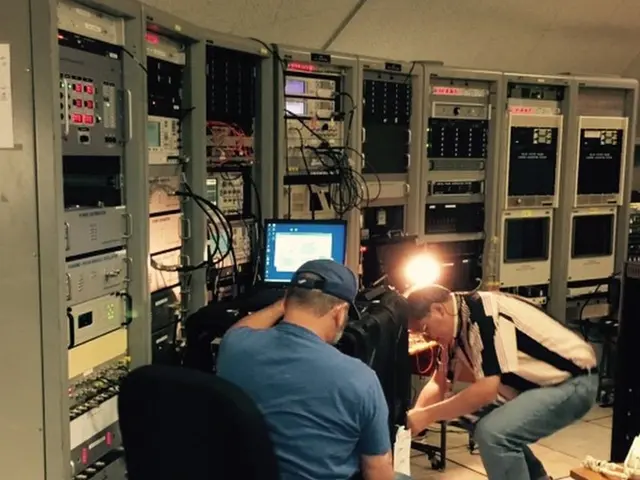Gearing Up: The Rush for New Wind Turbine Areas in Thuringia, Amid Pressure from the Federal Government
Wind farm identification accelerated amidst controversy: Thuringia's Regional Planners Explain Their Urgent Action Against Wind Farms
June 15, 2025, 05:00 AM
Thuringia has allocated less than half a percent of its land for wind turbines, leading to a long-standing halt in designating new priority areas. The tables have turned following the federal government's imposition of area contributions, forcing regional planners to swiftly find new locations.
By Lorene Gensel, for THÜRINGEN.com
Community Surprise: Unannounced Wind Turbine Proposals
Residents in Badra, Auleben, and Heringen in northern Thuringia had to confront an unexpected situation when representatives from the "Renewable Energy Factory" (EEF) approached them without prior warning. Eager to use their properties for wind turbine constructions, they presented meticulous field maps and lucrative offers, leaving many feeling overwhelmed.
In mid-May, EEF organized an information event for property owners in Nordhausen, discussing plans for ten to fourteen wind turbines north-west of Badra. These turbines would be of the Nordex 175 type, reaching over 280 meters from ground to rotor blade tip. Property owners were handed sample contracts at the event, and some even received ready-made contracts by Pentecost.
Resistance to Wind Power Expansion in Regional Policy
Thuringia's Regional Planning Associations—East, Middle, North, and Southwest—are tasked with designating wind turbine priority areas. This responsibility, however, has been a point of contention for some time, with Christian Democratic office holders delaying wind area expansion regionally for years. In Thuringia, the one-percent target set in the climate law remains elusive.
AKTUELL - Thuringian CDU Calls for a Rethink in Wind Power Expansion
With the Green Party's Robert Habeck taking over the Ministry for Economic Affairs and Energy, the one-percent target that previously seemed unattainable has now been turned into a law. The "Wind Turbine Land Requirements Act" (Wind-BG), passed seven months ago, mandates that two percent of Germany's area be available for wind energy by 2032 and 1.4 percent by 2027. Specifically, Thuringia must assign 2.2 percent and 1.8 percent of its area for wind turbine priority areas by 2032 and 2027, respectively.
Berlin Exerts Pressure with Area Requirements
Compared to the SPACE Program in Thuringia, the Wind-BG dictates strict regulations concerning wind turbine projects. Unlike previous scenarios where delays allowed Christian Democratic officeholders to stall wind energy expansion, the special §249 regulations of the Building Code for wind turbines already acknowledge that missed deadlines don't inhibit wind turbine applications, approvals, and construction.
Nordthüringen
Regions Scramble for New Wind Areas
The pressure from Berlin can be clearly observed in Thuringia, with each planning region actively working to meet the allocated area targets. In central Thuringia, the regional planning has already decided on a new draft featuring 44 wind priority areas and 11 areas for industrial power supply (2.3 percent of the area) by the end of 2023. East Thuringia followed suit, adopting a third draft, increasing the number of priority wind areas from 22 to 67 (1.7 percent of the area).
9.058 ha (2,5%)
Less is More: New Wind Turbines Near Jena Deliver Triple Performance
In another recent development, three new wind turbines near Jena have replaced six old ones, generating three times as much electricity since their implementation. The Santon, Saale-Holzland district experienced a ceremonial handover on June 9, 2025.
11.071 ha (3,0%)
Protests Arising from New Priority Areas
Citizens in Middle Thuringia have formed new initiatives following the publication of the maps for the new priority wind areas. Resistance is expected to increase in East Thuringia, where opposition to wind power has been strong. Even in North Thuringia, where wind turbine protests have been somewhat rare, resistance is growing, particularly in Badra, where locals hope "everything will be fine" on June 18, when the Regional Planning Assembly is scheduled to meet.
Opponents Have No Veto in Wind Planning
Unsurprisingly, the designation of wind areas is the responsibility of regional planning in Thuringia. This structure presents problems for wind power opponents and local councils, as protests and local council resolutions aren't factored into the planners' decisions. On the other hand, communities can plan wind parks themselves, away from the regional planning level, albeit without the status of a priority area.
Mittelthüringen
Video: Less is More: New Wind Turbines Near Jena Deliver Triple Performance
Link to the video
6.575 ha (1,8%)
Rights: MIDDLE GERMAN BROADCASTING
Wind Companies Left in Limbo
8.037 ha (2,2%)
Representatives of wind companies are aware of the regional planning criteria and conduct their analyses accordingly. While they share area proposals with the planning offices, mutual coordination is not in place. Instead, wind farm companies secure their areas independently, hoping that the regions will eventually designate their areas—at their own risk.
Balancing Regional Interests
Balancing regional interests is a key aspect of wind energy planning. With areas designated at a regional level, addressing questions related to people, infrastructure, agriculture, nature, and culture is necessary to weigh and balance the region's interests effectively.
East Thuringia Adopts New Regulation for Wind Farm Designation
Ostthüringen
On June 2, 2025, the Regional Planning Assembly of East Thuringia adopted the third draft, increasing the number of priority wind areas from 22 to 67 (1.7 percent of the area).
Communities Take Matter into Their Own Hands
6.632 ha (1,4%)
In Günserode, a village in the municipality of Kyffhäuserland, efforts to establish a wind park have been ongoing since 2014, but the community has yet to achieve success. Determined to benefit from the energy transition, Mayor Knut Hoffmann (CDU) has agreed with a wind company to financially benefit from the project in some way. However, these plans have not materialized due to regional planning hurdles.
In recent developments, the Thuringian government has created a way for communities like Günserode to establish their own wind areas in parallel to the regional planning process, promoting a more inclusive and locally-driven approach to wind energy expansion.
8.106 ha (1,7%)
Wind Energy Fact Check: Bird Shredding, Insect Decline, and Threatened Species
As the wind energy sector continues to grow, concerns regarding its potential impacts on wildlife have also arisen. This fact check can help separate myth from reality, clarifying common misconceptions surrounding the impacts of wind turbines on birds, insects, and endangered species.
More on Wind Power and Energy Transition
The energy sector is undergoing significant changes as Germany and other nations aim to transition to renewable energy sources. Understanding the implications of these changes and evaluating the various arguments will be crucial in shaping a sustainable and efficient future.
Südwestthüringen
Constituent Comments
Never Again Slavery 14 minutes ago
"Whether that's sensible and brings our country forward? I have serious doubts about that." Then ask yourself why the economic growth in Germany is almost zero.
6.899 ha (1,7%)
Mrs. K. 26 minutes ago
@AnniThen I want a public vote on whether commuters can still drive past my house. Only the residents vote. Done ;)Then they can vote, but they can't get any more external power, then they should shape their "island" autonomously. That's where the "I" becomes the "we" again...
Anni 28 minutes ago
8.432 ha (2,0%)
@MartinQuality and accessibility are important considerations, but it's crucial to find a balance between preserving personal convenience and supporting climate action and renewable energy expansion.
- In the discussions surrounding wind energy expansion in Thuringia, the Renewable Energy Factory (EEF) has approached residents unexpectedly in Badra, Auleben, and Heringen, presenting detailed field maps and financial offers for wind turbine constructions on their properties.
- Following the imposition of area contributions by the federal government, regional planners in Thuringia are under pressure to swiftly find new locations for wind turbines, as the tables have turned in the push for renewable energy.
- With the Green Party's Robert Habeck taking over the Ministry for Economic Affairs and Energy, the "Wind Turbine Land Requirements Act" (Wind-BG) mandates that two percent of Germany's area be available for wind energy by 2032 and 1.4 percent by 2027, forcing states like Thuringia to reassess their wind energy strategies in line with these targets.
- Taking a more proactive role in the wind energy transition, communities in Thuringia are now mobilizing to plan wind parks themselves, away from the regional planning level, albeit without the status of a priority area, as a way to financially benefit from the energy transition while addressing regional interests effectively.







